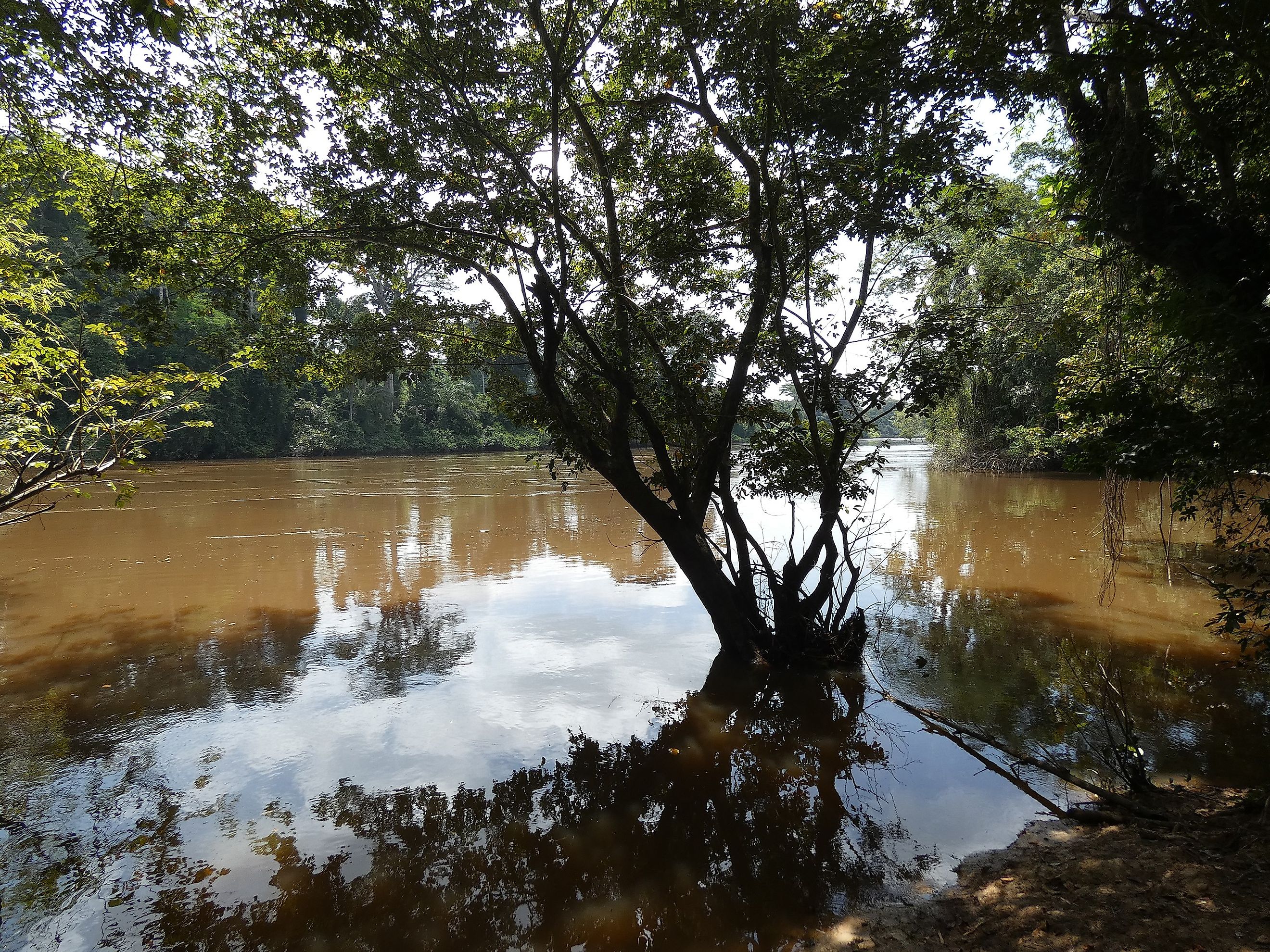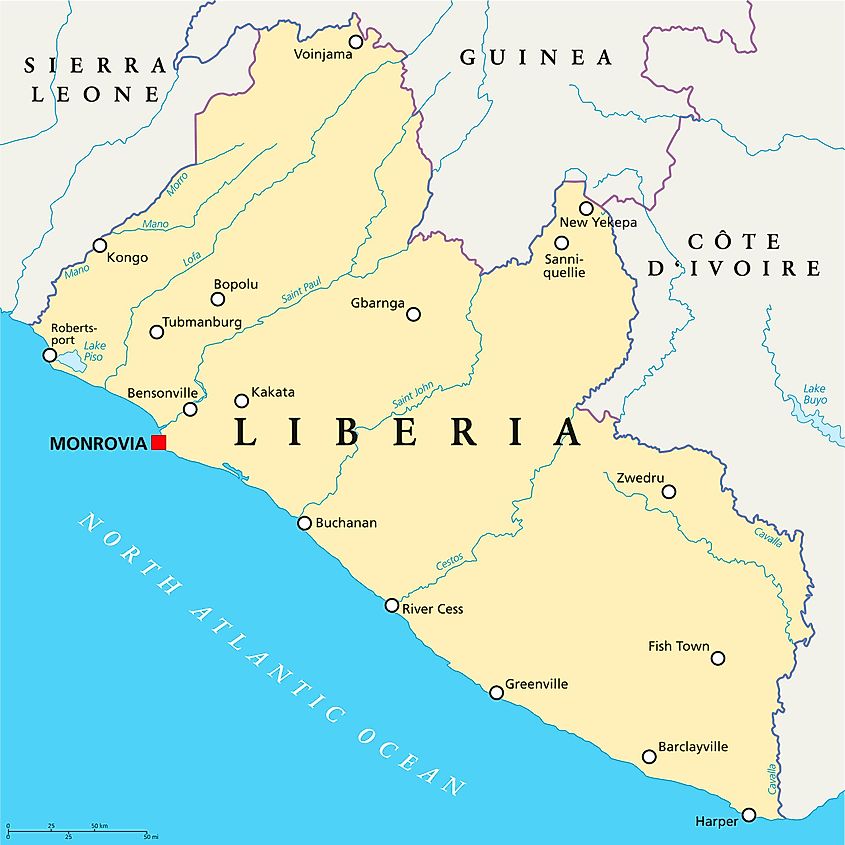
Cavalla River
The Cavalla River flows 320 miles across western Africa through the nations of Guinea, Cote d'Ivoire (Ivory Coast), and Liberia. Also known as the Cavally, the Youbou, and the Diougou, the Cavalla River serves as part of an international boundary, as well as a commercial and tourist waterway. Named in the 1400s by Portuguese explorers for the cavalla (horse mackerel) fish found in abundance near its mouth, the Cavalla River is also home to the unique "upside-down catfish" (Chiloglanis normani). While far from being Africa's longest or busiest river, the Cavalla has many distinctive qualities that make it an important and interesting waterway.
Source And Course

The Cavalla River begins its southward and eastward journey in the Nimba Range of the Guinea Highlands, to the north of Mount Nimba in Guinea. It soon passes into and through the nation of Cote d'Ivoire, then into Liberia towards the city of Zwedru. Shortly thereafter, the Cavalla serves as about one-third of the total length of the international boundary between Cote d'Ivoire and Liberia. The river heads south and empties into the Gulf of Guinea several miles east of Harper, Liberia. In total, the Cavalla River runs for about 320 miles. Including its major tributaries, the Duobe River and the Hana River, the Cavalla has a drainage area of nearly 12,000 square miles.
River Ecology
The Cavalla River flows through four major landscapes, starting in the Guinea Highlands, with mountain peaks in the range of 4,000 to 5,000 feet high. From there, the river passes through a forested plateau region that gradually slopes down into a transitional zone of forests, savannahs, and rolling hills. As the Cavalla approaches the Gulf of Guinea, which opens into the Atlantic Ocean, it flows through a coastal region of mangrove swamps, lagoons, and rocky outcroppings. Along with the cavalla (horse mackerel) fish that give the river its name and the curious "upside down catfish" (Chiloglanis normani), barracuda, mackerel, and even marlin can be found in the waters near the mouth of the Cavalla.
History Of The River

The Cavalla River was one of the waterways used by pre-colonial Western African kingdoms such as Ghana, Mali, and Ashanti. Portuguese navigators, who named the Cavalla in the late 1400s, initially hoped to use it to trade for gold from the interior, but they and other Europeans instead greatly expanded upon the existing trade in enslaved people. Since it is navigable further upstream than most nearby rivers, the Cavalla became an important waterway for the transatlantic slave trade. When Liberia was founded by formerly enslaved Americans in 1847, the borders were not yet settled, but the Cavalla eventually served as a significant portion of the border with neighboring Cote d'Ivoire (Ivory Coast).
River Commerce
The Cavalla is navigable for about 50 miles upriver from its opening into the Gulf of Guinea. This may not sound like a long distance, but it makes the Cavalla navigable deeper into the interior than other waterways in the area. While this navigability, unfortunately, made the river a part of the transatlantic slave trade in centuries past, the Cavalla is now used primarily for local and regional commerce. While not a major commercial waterway, the Cavalla plays a role in the trade in precious metals and minerals from the interior, as well as in the oil industry in the Gulf of Guinea—one of the largest oil-producing regions in the world.
River Tourism
Instability and conflict in the region, such as the long civil war in Liberia from the 1980s through the early 2000s and conflicts in Cote d'Ivoire in the early 2000s, have depressed the development of a tourist industry on and along the Cavalla River. That said, a return to relative stability in recent years has helped open the area to tourism. The Cavalla River and the adjacent Gulf of Guinea remain excellent fishing destinations, for instance, and the surrounding lands are renowned as great locales for birdwatching. Travelers can also venture into protected forest land in the region, such as Sapo National Park in Liberia, which contains the greatest diversity of mammal species of any location on Earth.
The Cavalla River in western Africa has served for centuries as one of the most important waterways opening into the Gulf of Guinea. The Cavalla played a role in the human tragedy known as the transatlantic slave trade, and its surrounding lands have seen more than enough conflict in recent decades. With cautious optimism for greater peace and stability in the region, however, hope exists that both locals and visitors alike will be able to appreciate the natural beauty of the Cavalla River and the territory it passes through.











